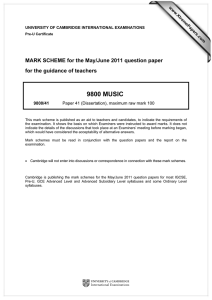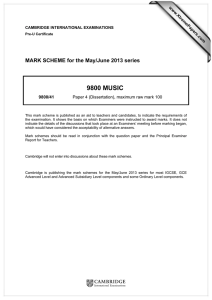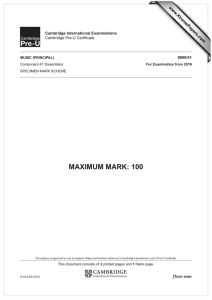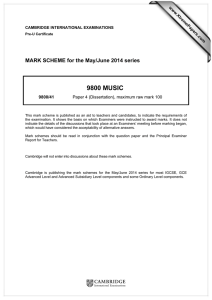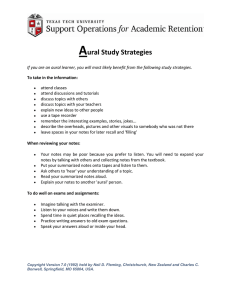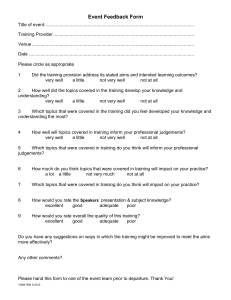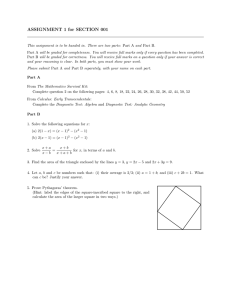9800 MUSIC MARK SCHEME for the May/June 2010 question paper
advertisement
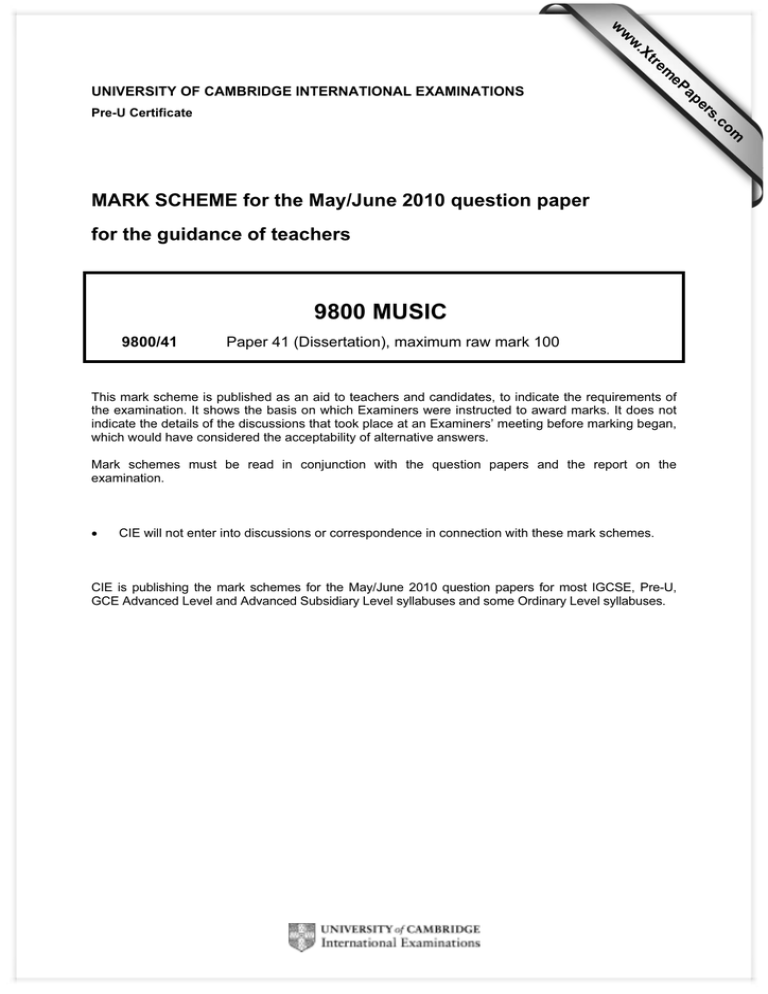
w w ap eP m e tr .X w UNIVERSITY OF CAMBRIDGE INTERNATIONAL EXAMINATIONS s er om .c Pre-U Certificate MARK SCHEME for the May/June 2010 question paper for the guidance of teachers 9800 MUSIC 9800/41 Paper 41 (Dissertation), maximum raw mark 100 This mark scheme is published as an aid to teachers and candidates, to indicate the requirements of the examination. It shows the basis on which Examiners were instructed to award marks. It does not indicate the details of the discussions that took place at an Examiners’ meeting before marking began, which would have considered the acceptability of alternative answers. Mark schemes must be read in conjunction with the question papers and the report on the examination. • CIE will not enter into discussions or correspondence in connection with these mark schemes. CIE is publishing the mark schemes for the May/June 2010 question papers for most IGCSE, Pre-U, GCE Advanced Level and Advanced Subsidiary Level syllabuses and some Ordinary Level syllabuses. Page 2 Mark Scheme: Teachers’ version Pre-U – May/June 2010 Syllabus 9800 Paper 41 The principal investigative tools should be aural ones; close familiarity with all aspects of the sound of the chosen music must be demonstrated and candidates are therefore advised to choose something which interests or excites them. The music for listening should be substantial: in order to understand fully the place of the chosen music in the repertoire or tradition from which it comes, it may also be advisable to listen, less intensively, to a wider range of relevant examples. It is important for candidates to ensure that adequate resources (particularly relevant CDs and suitable books) are available to support their investigation before they commit themselves to a particular topic. Background reading to support and extend the listening should be chosen not only to be appropriate to the topic. Candidates will need to learn to discriminate in their reading between what is significant, just relevant or merely incidental to their line of enquiry. Candidates should express themselves clearly in their own words; when they wish to quote what other commentators say this should always be properly acknowledged in a footnote reference to their bibliography. Whenever possible, assertions about the music should be illustrated by precise reference to an example either from the printed music or a recording. (It may be beneficial to supply brief recorded extracts to accompany the text.) Assessment Criteria 1 Aural perception Descriptors Marks Keen aural perception and a sharp focus on significant features. 17–20 Good aural perception and a consistent focus on significant features. 13–16 An adequate level of aural awareness and ability to recognise what is significant. 9–12 Some evidence of aural awareness and ability to recognise what is significant. 5–8 A weak aural response with little awareness of significant features. 1–4 No evidence of any listening at all. 2 0 Contextual understanding Descriptors Marks A wide range of scholarly reading/research informs a secure understanding of significant contextual matters. 17–20 An appropriate range of mostly scholarly reading/research knowledgeable references to relevant contextual matters. 13–16 informs A limited amount of appropriate reading/research, of variable scholarly standard, is drawn on to sketch a relevant context. 9–12 A very limited amount of reading/research undertaken, including some scholarly sources, showing some understanding of relevant background. 5–8 Some evidence of reading/research at a mainly low level of scholarship and some attempt to establish background but of only partial relevance. 1–4 No evidence of any relevant background knowledge. © UCLES 2010 0 Page 3 3 Mark Scheme: Teachers’ version Pre-U – May/June 2010 Syllabus 9800 Analytic/investigative techniques and technical vocabulary Descriptors Marks Confident use of appropriate analytic/investigative techniques precisely explained using correct technical vocabulary. 17–20 Mostly confident application of appropriate analytic/investigative techniques explained clearly using technical vocabulary. 13–16 Fairly confident application of appropriate analytic/investigative techniques explained using some technical vocabulary. 9–12 A sensible attempt to investigate relevant aspects of the music partly supported by necessary terminology. 5–8 Some attempt to investigate the music hampered by an insecure grasp of technical vocabulary. 1–4 No attempt at analytic/investigative exploration of the music. 4 0 Substantiation of judgements Descriptors Marks All judgements substantiated by wholly apt examples chosen independently of other commentators, securely identified and flawlessly referenced. 17–20 Nearly all judgements substantiated by entirely appropriate, clearly-located and correctly-referenced examples. 13–16 Most judgements supported by appropriate examples, some derived with acknowledgement from other commentators. 9–12 Some judgements illustrated by examples, leaning heavily on other commentators. 5–8 A few judgements illustrated by derivative examples. 1–4 No examples or illustrative material of any kind offered to support the text. 5 Paper 41 0 Communication of findings and acknowledgements Descriptors Marks A thoroughly convincing coherent presentation, meticulously documented. 17–20 A convincing presentation, carefully documented. 13–16 A mostly convincing presentation, adequately documented. 9–12 A patchy presentation, incompletely documented. 5–8 A weak presentation, poorly documented. 1–4 Incoherent and undocumented. 0 © UCLES 2010
